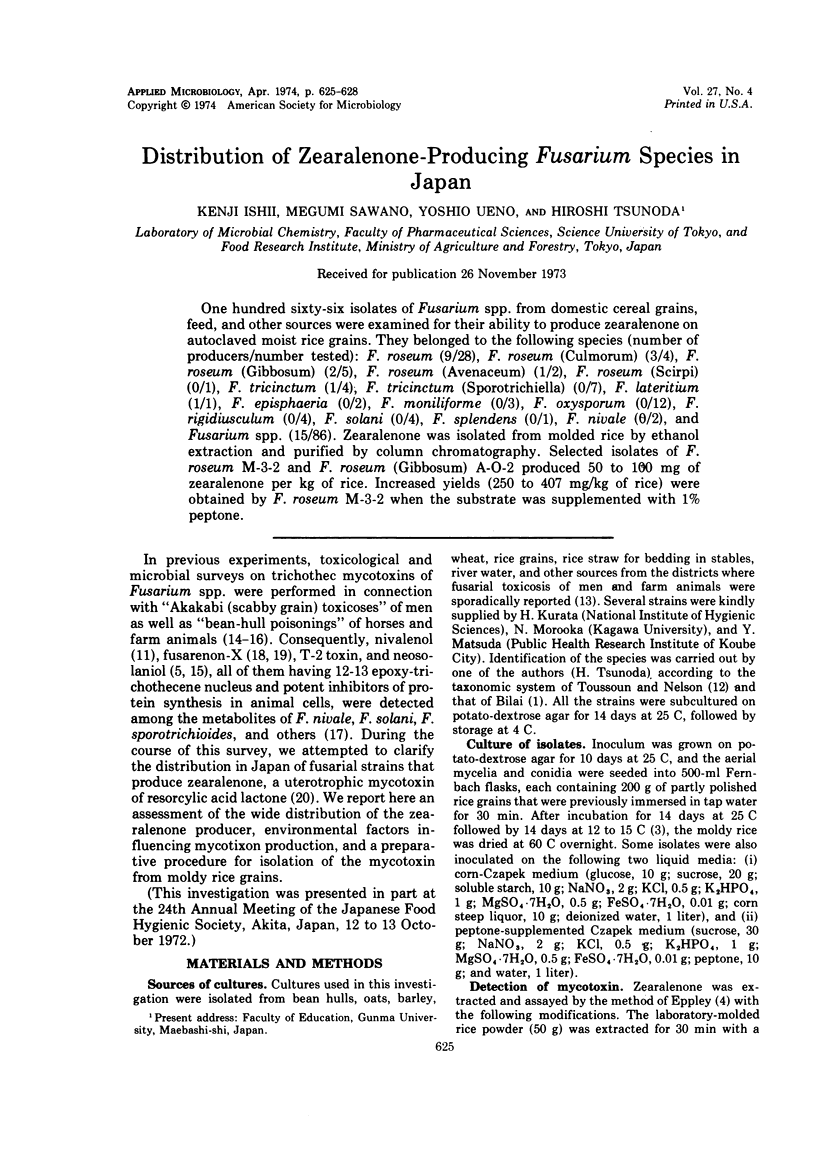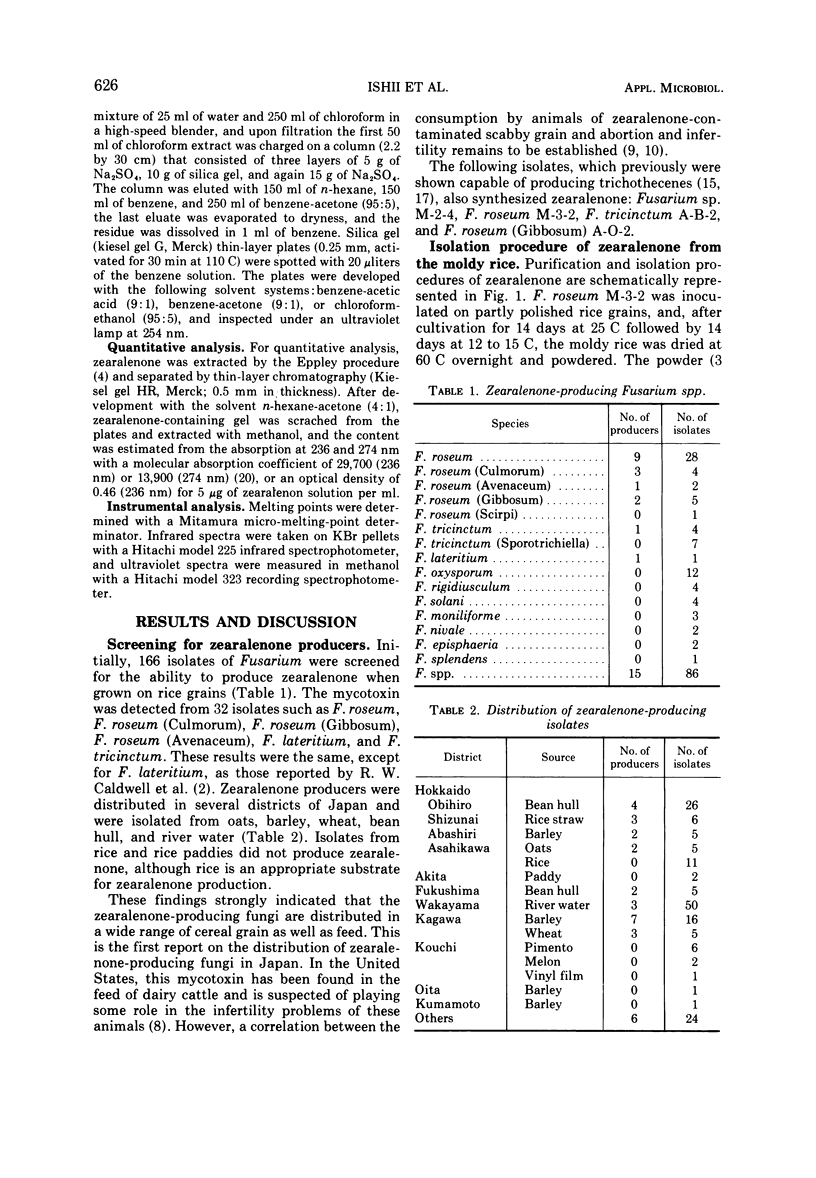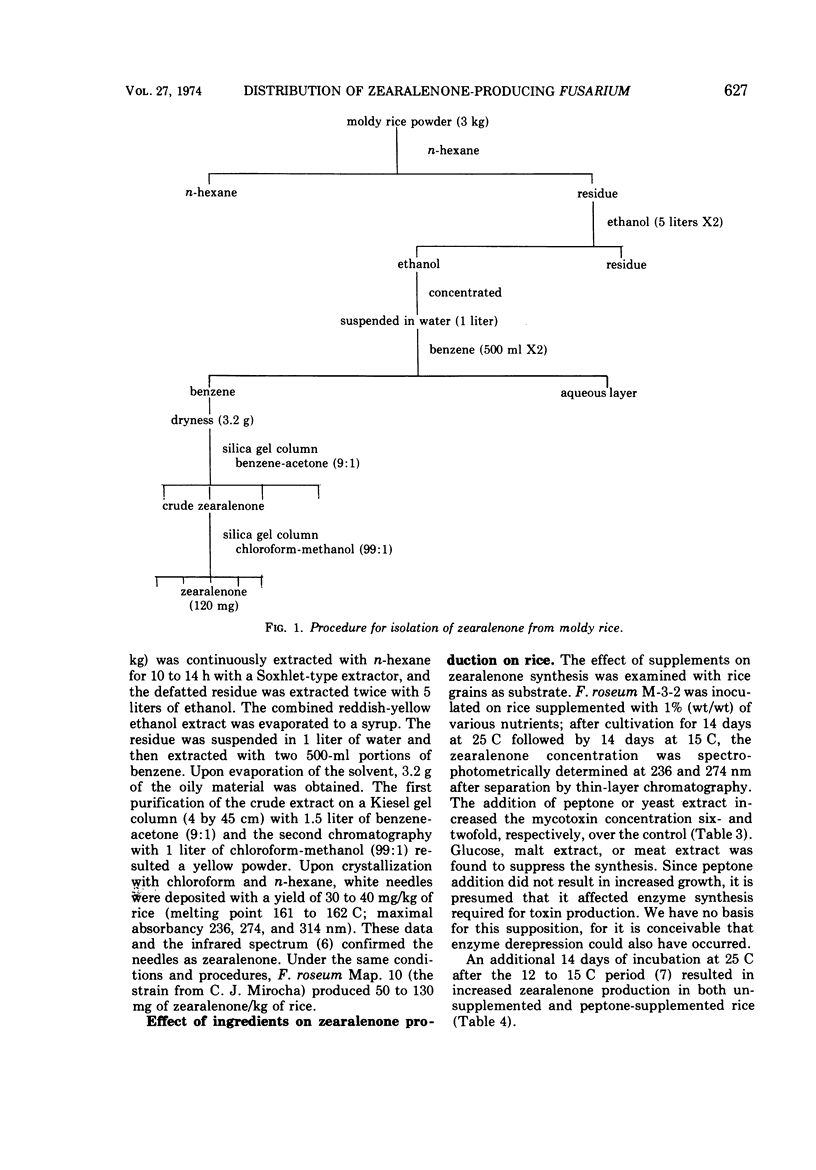Abstract
One hundred sixty-six isolates of Fusarium spp. from domestic cereal grains, feed, and other sources were examined for their ability to produce zearalenone on autoclaved moist rice grains. They belonged to the following species (number of producers/number tested): F. roseum (9/28), F. roseum (Culmorum) (3/4), F. roseum (Gibbosum) (2/5), F. roseum (Avenaceum) (1/2), F. roseum (Scirpi) (0/1), F. tricinctum (1/4), F. tricinctum (Sporotrichiella) (0/7), F. lateritium (1/1), F. episphaeria (0/2), F. moniliforme (0/3), F. oxysporum (0/12), F. rigidiusculum (0/4), F. solani (0/4), F. splendens (0/1), F. nivale (0/2), and Fusarium spp. (15/86). Zearalenone was isolated from molded rice by ethanol extraction and purified by column chromatography. Selected isolates of F. roseum M-3-2 and F. roseum (Gibbosum) A-O-2 produced 50 to 100 mg of zearalenone per kg of rice. Increased yields (250 to 407 mg/kg of rice) were obtained by F. roseum M-3-2 when the substrate was supplemented with 1% peptone.
Full text
PDF



Selected References
These references are in PubMed. This may not be the complete list of references from this article.
- Caldwell R. W., Tuite J., Stob M., Baldwin R. Zearalenone production by Fusarium species. Appl Microbiol. 1970 Jul;20(1):31–34. doi: 10.1128/am.20.1.31-34.1970. [DOI] [PMC free article] [PubMed] [Google Scholar]
- Christensen C. M., Nelson G. H., Mirocha C. J. Effect on the white rat uterus of a toxic substance isolated from Fusarium. Appl Microbiol. 1965 Sep;13(5):653–659. doi: 10.1128/am.13.5.653-659.1965. [DOI] [PMC free article] [PubMed] [Google Scholar]
- Ishii K., Sakai K., Ueno Y., Tsunoda H., Enomoto M. Solaniol, a toxic metabolite of Fusarium solani. Appl Microbiol. 1971 Oct;22(4):718–720. doi: 10.1128/am.22.4.718-720.1971. [DOI] [PMC free article] [PubMed] [Google Scholar]
- Mirocha C. J., Christensen C. M., Nelson G. H. Estrogenic metabolite produced by Fusarium graminearum in stored corn. Appl Microbiol. 1967 May;15(3):497–503. doi: 10.1128/am.15.3.497-503.1967. [DOI] [PMC free article] [PubMed] [Google Scholar]
- Mirocha C. J., Harrison J., Nichols A. A., McClintock M. Detection of a fungal estrogen (F-2) in hay associated with infertility in dairy cattle. Appl Microbiol. 1968 May;16(5):797–798. doi: 10.1128/am.16.5.797-798.1968. [DOI] [PMC free article] [PubMed] [Google Scholar]
- Tatsuno T., Saito M., Enomoto M., Tsunoda H. Nivalenol, a toxic principle of Fusarium nivale. Chem Pharm Bull (Tokyo) 1968 Dec;16(12):2519–2520. doi: 10.1248/cpb.16.2519. [DOI] [PubMed] [Google Scholar]
- Ueno Y., Ishii K., Sakai K., Kanaeda S., Tsunoda H. Toxicological approaches to the metabolites of Fusaria. IV. Microbial survey on "bean-hulls poisoning of horses" with the isolation of toxic trichothecenes, neosolaniol and T-2 toxin of Fusarium solani M-1-1. Jpn J Exp Med. 1972 Jun;42(3):187–203. [PubMed] [Google Scholar]
- Ueno Y., Ishikawa Y., Nakajima M., Sakai K., Ishii K. Toxicological approaches to the metabolites of Fusaria. I. Screening of toxic strains. Jpn J Exp Med. 1971 Aug;41(4):257–272. [PubMed] [Google Scholar]
- Ueno Y., Sato N., Ishii K., Sakai K., Tsunoda H. Biological and chemical detection of trichothecene mycotoxins of Fusarium species. Appl Microbiol. 1973 Apr;25(4):699–704. doi: 10.1128/am.25.4.699-704.1973. [DOI] [PMC free article] [PubMed] [Google Scholar]
- Ueno Y., Ueno I., Amakai K., Ishikawa Y., Tsunoda H. Toxicological approaches to the metabolites of Fusaria. II. Isolation of fusarenon-X from the culture filtrate of Fusarium nivale Fn 2B. Jpn J Exp Med. 1971 Dec;41(6):507–519. [PubMed] [Google Scholar]
- Ueno Y., Ueno I., Tatsuno T., Ookubo K., Tsunoda H. Fusareon-X, a toxic principle of Fusarium nivale--culture filtrate. Experientia. 1969 Oct 15;25(10):1062–1062. doi: 10.1007/BF01901430. [DOI] [PubMed] [Google Scholar]


